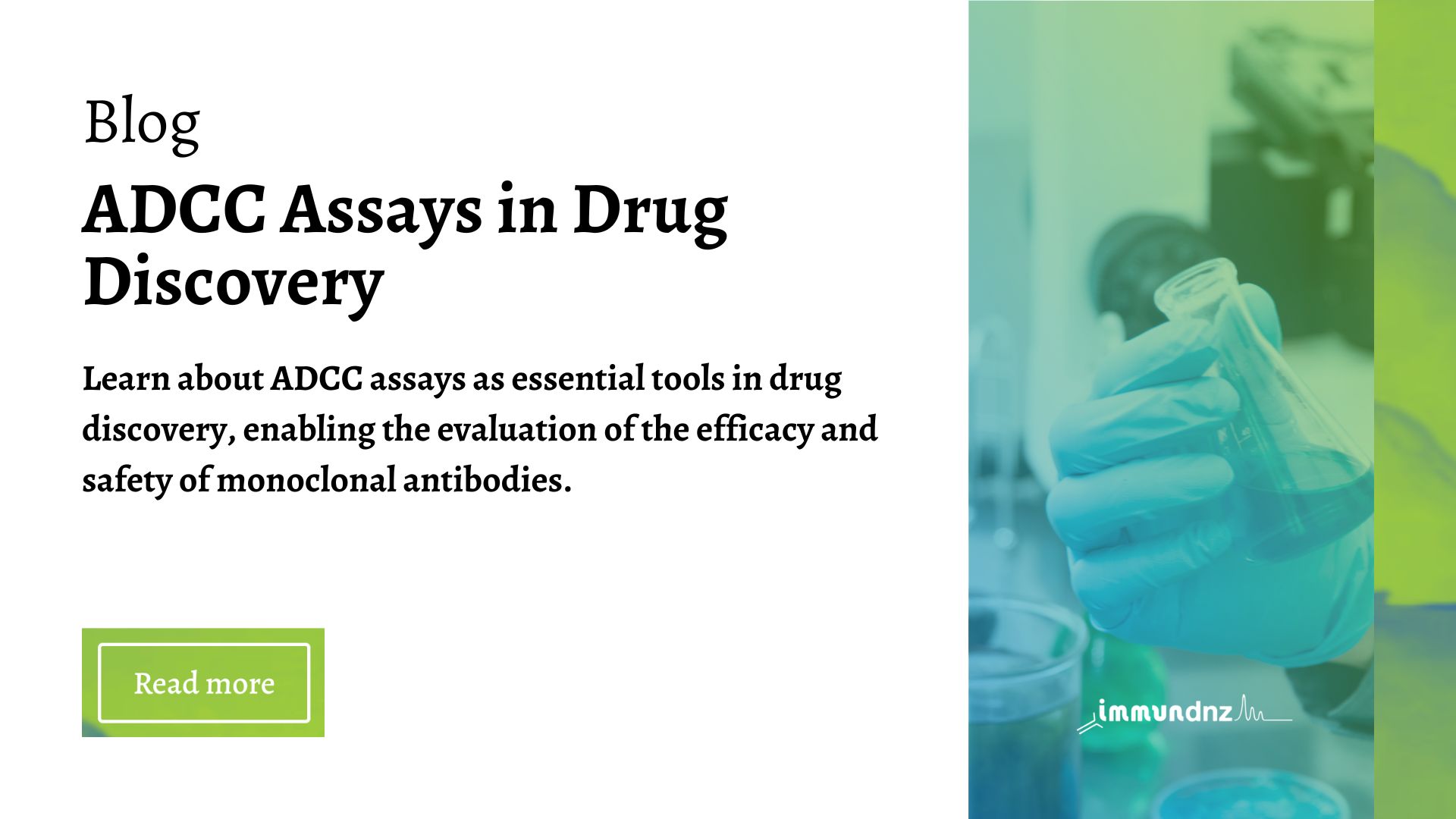Antibody-dependent cellular cytotoxicity (ADCC) is a pivotal immune mechanism whereby effector cells, such as natural killer (NK) cells, recognize and lyse target cells that are opsonized with antibodies. This process is integral to the function of many therapeutic antibodies, particularly in oncology and infectious diseases. ADCC assays are essential tools in drug discovery, enabling the evaluation of the efficacy and safety of monoclonal antibodies (mAbs). We will discuss the principles of ADCC, its significance in drug development, various assay methodologies, and the challenges and advancements in the field.
Principle of ADCC
ADCC is a critical immune response that involves the following steps:
1. Antibody Binding: Therapeutic antibodies bind to specific antigens on the surface of target cells, such as cancer cells or virus-infected cells.
2. Effector Cell Engagement: The Fc region of these bound antibodies interacts with Fc gamma receptors (FcγR) on effector cells, predominantly NK cells, but also macrophages and neutrophils.
3. Cytotoxic Response: This interaction activates the effector cells to release cytotoxic granules containing perforin and granzymes, leading to the lysis and death of the antibody-coated target cells.
The efficacy of therapeutic antibodies in mediating ADCC depends on several factors, including the affinity of the antibody for the FcγR on effector cells, the density of target antigen expression, and the presence of competing antibodies or immune modulators.
The Importance of ADCC in Drug Discovery
Significance of ADCC in Drug Discovery
In drug discovery, particularly for cancer immunotherapy and infectious disease treatment, ADCC is a crucial mechanism by which therapeutic antibodies exert their effects. Evaluating ADCC activity is vital for several reasons:
1. Efficacy Assessment: ADCC assays help determine the ability of candidate antibodies to mediate the destruction of target cells, thus providing an early indication of therapeutic potential.
2. Optimization of Antibody Engineering: Modifications to the Fc region of antibodies can enhance their binding affinity to FcγRs, thereby improving ADCC activity. Assays are essential to assess the impact of these modifications.
3. Comparative Studies: ADCC assays allow for the comparison of different antibody candidates to identify the most potent ones.
4. Safety Evaluation: Assessing ADCC helps ensure that therapeutic antibodies selectively target diseased cells without causing excessive damage to normal cells.
Types of ADCC Assays
Several methodologies are employed to measure ADCC activity, each with its advantages and limitations.
1. Chromium Release Assay (CRA):
– Principle: Target cells are labeled with radioactive chromium-51 (51Cr). When these cells are lysed by effector cells, the released 51Cr is measured in the supernatant.
– Advantages: High sensitivity and established methodology.
– Limitations: Radioactive hazards, labor-intensive, and requires specialized equipment.
2. Flow Cytometry-Based Assays:
– Principle: Target cells are labeled with fluorescent dyes, and their lysis by effector cells is measured by the loss of fluorescence. Effector and target cells can be distinguished using specific markers.
– Advantages: Allows detailed analysis of cell populations and interactions, non-radioactive.
– Limitations: Requires flow cytometry expertise and equipment, potential for dye dilution.
3. Luminescence-Based Assays:
– Principle: Target cells are engineered to express a luminescent reporter gene (e.g., luciferase). The lysis of target cells results in a decrease in luminescence, which is measured using a luminometer.
– Advantages: High sensitivity, non-radioactive, amenable to high-throughput screening.
– Limitations: Requires genetic modification of target cells, potential variability in reporter expression.
4. Enzyme-Linked Immunosorbent Assay (ELISA)-Based Assays:
– Principle: Detection of cytokines (e.g., interferon-gamma) released by effector cells upon activation. This indirect measurement correlates with ADCC activity.
– Advantages: Established technology, non-radioactive.
– Limitations: Indirect measure, may not accurately reflect target cell lysis.
Assay Development
When developing ADCC assays, several factors must be considered to ensure reliable and reproducible results:
– Effector to Target (E:T) Ratio: The ratio of effector cells to target cells is critical. An optimal E:T ratio must be determined to balance sensitivity and specificity.
– Effector Cell Source: Primary NK cells or NK cell lines (e.g., NK-92) can be used. Primary cells are more physiologically relevant, while cell lines offer consistency and ease of use.
– Antibody Concentration: The concentration of therapeutic antibodies must be optimized to reflect therapeutic levels and ensure meaningful assessment of ADCC activity.
– Fc Receptor Polymorphisms: Variability in FcγR expression and polymorphisms can affect ADCC activity. Using effector cells with well-characterized FcγR profiles is essential.
At Immundnz we can advise you on the right design of the ADCC assay for your application.
Challenges and Future Directions
Despite the importance of ADCC assays in drug discovery, several challenges remain:
– Complexity and Variability: ADCC involves multiple cell types and interactions, leading to variability in assay results. Standardizing assay conditions and using well-characterized reagents can mitigate this issue.
– In Vivo Relevance: In vitro ADCC assays may not fully capture the complexity of in vivo immune responses. Bridging in vitro findings with in vivo models is necessary for a comprehensive evaluation.
– Effector Cell Availability: Sourcing primary NK cells can be challenging and variable. NK cell lines provide a consistent alternative but may not fully replicate primary cell responses.
Expected future directions for ADCC assays are:
– High-Throughput Screening (HTS): Development of HTS-compatible ADCC assays can accelerate the identification and optimization of therapeutic antibodies.
– Advanced Imaging Techniques: High-resolution imaging techniques, such as live-cell imaging, can provide detailed insights into the dynamics of ADCC at the single-cell level.
– Three-Dimensional (3D) Culture Systems: Incorporating 3D culture systems and organoids can offer more physiologically relevant models for studying ADCC.
Conclusion
ADCC assays are indispensable in the realm of drug discovery, especially for the development of monoclonal antibodies aimed at treating cancer and infectious diseases. These assays provide crucial insights into the functional activity of therapeutic antibodies by assessing their ability to mediate the destruction of diseased cells via immune mechanisms. Despite the challenges associated with ADCC assays, ongoing advancements in assay technologies and methodologies continue to enhance their relevance and application in drug discovery. By understanding and leveraging ADCC, researchers can develop more effective and targeted therapies, ultimately improving patient outcomes.


